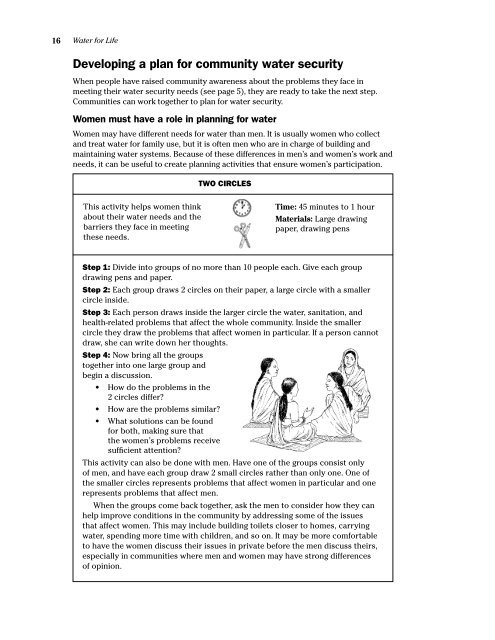Community water security - UN-Water
Community water security - UN-Water
Community water security - UN-Water
Create successful ePaper yourself
Turn your PDF publications into a flip-book with our unique Google optimized e-Paper software.
16<br />
<strong>Water</strong> for Life<br />
Developing a plan for community <strong>water</strong> <strong>security</strong><br />
When people have raised community awareness about the problems they face in<br />
meeting their <strong>water</strong> <strong>security</strong> needs (see page 5), they are ready to take the next step.<br />
Communities can work together to plan for <strong>water</strong> <strong>security</strong>.<br />
Women must have a role in planning for <strong>water</strong><br />
Women may have different needs for <strong>water</strong> than men. It is usually women who collect<br />
and treat <strong>water</strong> for family use, but it is often men who are in charge of building and<br />
maintaining <strong>water</strong> systems. Because of these differences in men’s and women’s work and<br />
needs, it can be useful to create planning activities that ensure women’s participation.<br />
TWO CIRCLES<br />
This activity helps women think<br />
about their <strong>water</strong> needs and the<br />
barriers they face in meeting<br />
these needs.<br />
Time: 45 minutes to 1 hour<br />
Materials: Large drawing<br />
paper, drawing pens<br />
Step 1: Divide into groups of no more than 10 people each. Give each group<br />
drawing pens and paper.<br />
Step 2: Each group draws 2 circles on their paper, a large circle with a smaller<br />
circle inside.<br />
Step 3: Each person draws inside the larger circle the <strong>water</strong>, sanitation, and<br />
health-related problems that affect the whole community. Inside the smaller<br />
circle they draw the problems that affect women in particular. If a person cannot<br />
draw, she can write down her thoughts.<br />
Step 4: Now bring all the groups<br />
together into one large group and<br />
begin a discussion.<br />
• How do the problems in the<br />
2 circles differ?<br />
• How are the problems similar?<br />
• What solutions can be found<br />
for both, making sure that<br />
the women’s problems receive<br />
sufficient attention?<br />
This activity can also be done with men. Have one of the groups consist only<br />
of men, and have each group draw 2 small circles rather than only one. One of<br />
the smaller circles represents problems that affect women in particular and one<br />
represents problems that affect men.<br />
When the groups come back together, ask the men to consider how they can<br />
help improve conditions in the community by addressing some of the issues<br />
that affect women. This may include building toilets closer to homes, carrying<br />
<strong>water</strong>, spending more time with children, and so on. It may be more comfortable<br />
to have the women discuss their issues in private before the men discuss theirs,<br />
especially in communities where men and women may have strong differences<br />
of opinion.
















